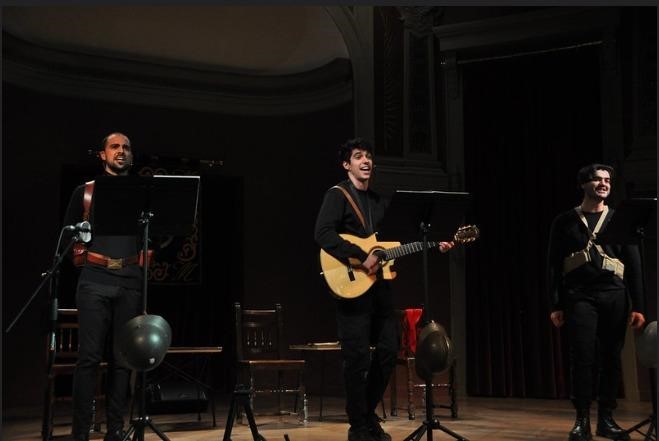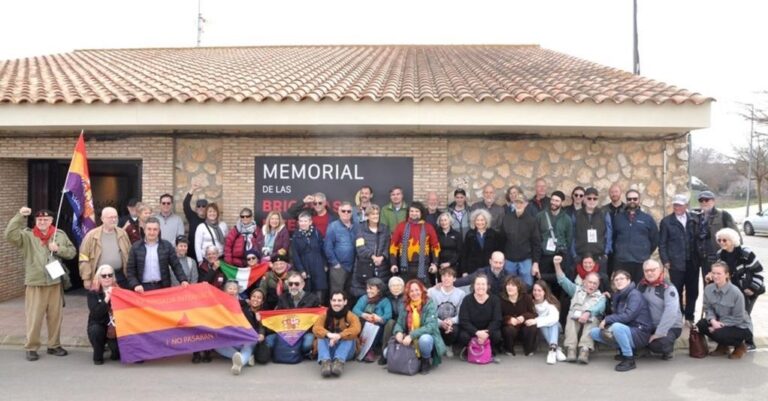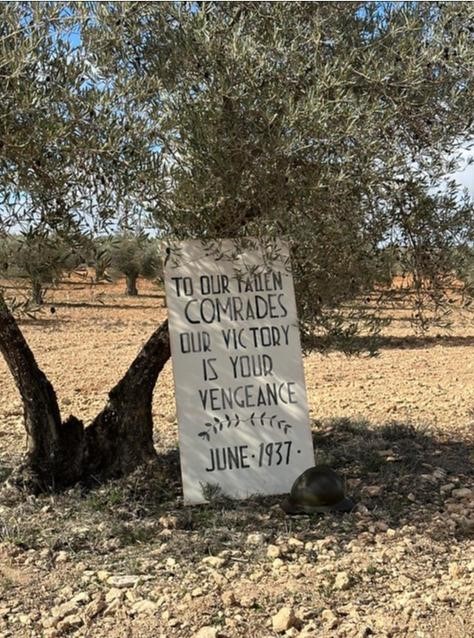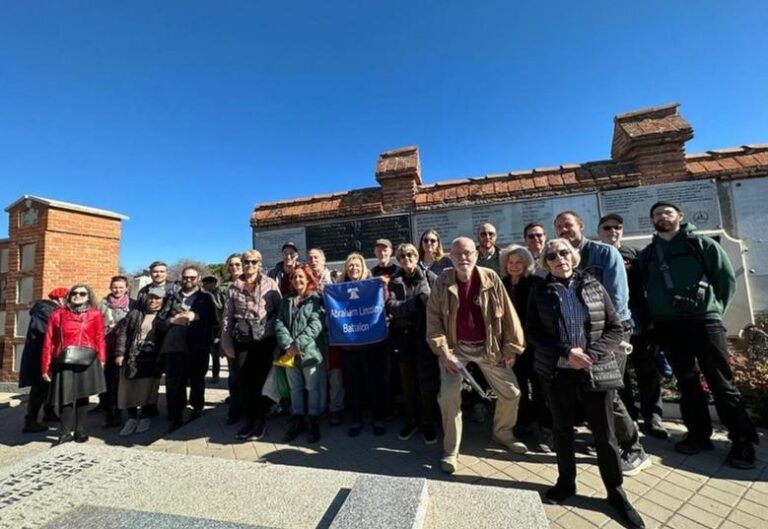The Brigadistas’ Living Memory: Jarama, 2025
(For the original version in Spanish, see below.)
This year the commemoration of the Battle at Jarama–a key battle in the development of the Spanish War–was dedicated to the volunteers of the Lincoln Battalion of the XV International Brigade. It took place during four days, between February 20 and 23. For the occasion, about forty-five descendants and friends of the American volunteers came expressly from the United States. We also had a large group of friends from the United Kingdom, Ireland, Canada, Switzerland, and Italy, belonging to our sister associations IBMT, FIBI, AICVAS. (See here for a report from Nancy Wallach.)
On Thursday, the 20th, we began these days of remembrance with a dramatized reading of a play written by the American Brigadier Charles Nusser. It is difficult to describe the emotions we experienced during that hour and a half in the impressive auditorium of the Ateneo de Madrid. One of them was due to the fact that it was the first time that this play was performed on stage. A fact, moreover, that had something miraculous, since the text was about to disappear in the fire of the house of one of the descendants of Nusser. It was precisely Nusser’s granddaughter, Kate Fogarty, who sent the text to AABI a little less than a year ago. (Read her story here.) And in these months AABI has managed to translate it, to obtain the support of the Ministry of Democratic Memory and the Ateneo, and to get a group of illustrious actors, led by Juan Pastor and Jeannine Mestre, who selflessly got down to work so that Nusser’s words recounting the epic of the Lincolns would come to life in the voices of four magnificent actors, in addition to Mestre herself.
Surely one of the people who felt the most emotion was Nusser’s own granddaughter, Kate, whom the performance of the cast and the vibrant songs interpreted by Nacho Vera and Javier Madruga reminded of the fact that, for her grandfather, the anti-fascist struggle in Spain was the most important thing he did in his life, as she said during an interesting discussion with Almudena Cros, President of the AABI, after the end of the dramatized reading.

Carlos Manrique, Javier Madruga y Luis Miguel Pareja en el Ateneo de Madrid (Foto: Len y Nancy Tsou)
On Friday, the group boarded a bus to visit another memory site linked to the Lincolns: the Albacete town of Madrigueras. It was in this town where the American volunteers were billeted during their training phase before going into combat. Given the large number of volunteers arriving in the city of Albacete, which created a problem of accommodation and supplies, it was decided to spread them throughout the nearby towns, such as Mahora, Casas Ibáñez or Madrigueras, among others. It was precisely in Madrigueras where the English-speaking volunteers ended up.
And it is there where a couple of years ago a fantastic memorial dedicated to this episode of its local history was inaugurated. The visit was coordinated both with the Mayor of Madrigueras, Juan Carlos Talavera, who received the group at the Town Hall, and with Alfredo Alcahut, who is responsible for the memorial and who guided the group through the most important places in the town for the brigaders, such as the parish church and, of course, the memorial itself, which is the only one of its kind in the whole province, and where the memory of the International Brigades is honored. Alfredo also explained how he works with dozens of young people in the area so that they understand this extraordinary historical episode. An example of democratic memory put into practice with rigor and emotion.
The visit to Madrigueras ended with a meal in a local restaurant before returning to Madrid, stopping first in Tarancon, a city with a very important meaning for the interbrigadistas, with its still standing “Hospitalillo”, which testifies to the role played by Tarancon as a health base, which is why it suffered an ominous and cruel bombing by fascist aircraft in February 1937, precisely during the development of the Battle of Jarama. In addition, two illustrious American brigadists passed through Tarancón: Doctor Barsky and the African American nurse Salaria Kea.
And this is how we reached the climax of our annual days: the visit to the battlefield. Saturday the 22nd dawned unseasonably, with low clouds rising over the valleys of the Jarama and the Tajuña, covering the rooftops of Morata with their mist. The group contemplated them from the height where the monument to Charlie Donnelly stands, gathered in front of the humble group of stones that commemorates that young Irish poet whose life was taken away, among bleeding olive trees, by fascist bullets. Fortunately the day began to open up, allowing the sun to brighten the march of the several hundred people who accompanied us in our tribute to the heroes of Jarama. Miguel Angel Garcia, a member of TAJAR and an expert in history, was kind enough to act as our guide during the march, something he has been doing for several years now, in an excellent way.
Red, yellow and purple were back, along with the three-pointed star to be seen on dozens of flags that dotted the long column of BI supporters up to the first stop. There Miguel Angel explained to us the importance of the place where we were. It was in that location, in front of the Pingarrón massif, where the Lincoln brigadiers had to carry out the order received from the Republican command: to stop the advance of the Moors and legionnaires. The fighting was fierce, but the result was that that battalion formed by volunteers, most of them without military training and poorly armed, managed to annihilate Franco’s military forces, professional, experienced and better equipped.
After the historical explanation, the descendants of the brigadistas who accompanied us pronounced aloud the names of their relatives who had fought in those same camps. In addition, Lin Rose Clark, of the IBMT, spoke about the book written by her grandfather, Brigadier Robert Hilliard, Swift Blaze of Fire. Then Alex Paunov, grandson of Bulgarian Brigadier Ivan Paunov, who was the first Commander of the Dimitrov Battalion and who died of wounds sustained while leading his Battalion’s attack against Franco’s troops on February 17, 1937 at the Battle of Jarama, very close to where we had started the march, spoke. Linda Geiser, daughter of Carl Geiser, Commissar of the XV BI and Nancy Wallach, daughter of Hy Wallach, American brigadier of Polish Jewish origin, also intervened. (Read her report here.)
The march continued until we were close to the area where the Lincolns’ trenches were finally established, once the battle was over and the front was stabilized. There Miguel Angel explained to us the events of February 27, a date marked in the memory of the brigadiers of the Lincoln Battalion for having suffered an enormous amount of casualties when trying to carry out an almost suicidal attack order, given the lack of artillery or air preparation that would have been necessary to take a position so well defended by the enemy.
It was at this point of the route where we had planned to have the presence of our colleague José María Olivera, expert and researcher, who was going to reveal to us the place where the American brigadiers erected their famous monument in 1937, before leaving the front, in memory of their fallen comrades. José María, after much archival and field work, has found it, but a small domestic accident prevented him from joining us this year. We hope that soon he will be able to accompany us to such an important place. For the time being, we had to content ourselves with temporarily placing a replica of the poster that the American brigadier Mark Rauschwald made at the time, with his famous slogan “our victory will be your vengeance”.
After the walk, we headed to Rivas Vaciamadrid where we had a fellowship meal to regain strength and discuss everything we had experienced.
On Sunday 23rd we had our last act of these days of memory: the visit to the Cemetery of Fuencarral. For many of the attendees it was the first time they were in that cemetery, a place strongly linked to the International Brigades, since it was there where General Lukacs decided to bury the volunteers killed in the successive battles in the vicinity of Madrid. For this reason, almost five hundred brigaders (most of them Spanish) fallen in Casa de Campo, Ciudad Universitaria, Boadilla, Majadahonda, Jarama, Guadalajara or Brunete were buried with honors by their comrades, between 1936 and 1937. And there they remained until the Falangist town hall of Fuencarral decided in 1941 to desecrate and destroy the cemetery.
The group gathered in front of the monument to the Soviet Volunteers and in front of the plaques commemorating the international brigaders, observing a minute of silence after pronouncing the names of the nine volunteers from the United States who appear on the list of the Funeral Service of the International Brigades.
The day concluded with a visit to the site of the suspected mass grave where the remains of those 451 brigaders were thrown. Earlier, at the monument to the Soviet Volunteers, Alex Paunov was moved to find his grandfather’s name engraved on one side of the monument, along with the names of the Soviets killed during our war, (Ivan Paunov, although Bulgarian by birth, resided in the USSR since 1925 and had Soviet nationality).
And so concluded some unforgettable days; our friends from abroad returned home with the living memory of the international brigadistas and their struggle in the Jarama Valley, a necessary memory to be able to face the threats that international neo-fascism and warmongering capitalism give us daily. They returned knowing that Spain does not forget its International Volunteers.
Este año las jornadas de conmemoración de aquella batalla clave en el desarrollo de la Guerra de España, estuvieron dedicadas a los voluntarios del Batallón Lincoln de la XV BI y se desarrollaron durante cuatro días, entre el 20 y el 23 de febrero.
Para la ocasión, vinieron expresamente desde Estados Unidos alrededor de cuarenta y cinco descendientes y amigos de los voluntarios norteamericanos. También contamos con un numeroso grupo de amigos llegados del Reino Unido, Irlanda, Canadá, Suiza e Italia, pertenecientes a nuestras asociaciones hermanas IBMT, FIBI, AICVAS.
El jueves 20 dimos comienzo a estas jornadas de memoria con la lectura dramatizada de una obra de teatro escrita por el brigadista estadounidense Charles Nusser. Es difícil describir la cantidad de emociones que vivimos durante aquella hora y media en el imponente salón de actos del Ateneo de Madrid. Una de ellas se debió al hecho de que era la primera vez que dicha obra se llevaba a un escenario. Hecho, además, que tuvo algo de milagroso, ya que el texto a punto estuvo de desaparecer en el incendio de la casa de uno de los descendientes de Nusser. Fue precisamente la nieta de Nusser, Kate Fogarty quien envió a la AABI el texto hace algo menos de un año. Y en estos meses la AABI ha logrado traducirlo, obtener el apoyo del Ministerio de Memoria Democrática y del Ateneo, e ilusionar a un grupo de ilustres de la escena, encabezado por Juan Pastor y Jeannine Mestre, que desinteresadamente se pusieron manos a la obra para que las palabras de Nusser relatando la epopeya de los Lincolns cobraran vida en las voces de cuatro magníficos actores, además de la propia Mestre.
Seguramente una de las personas que más emoción sintió fue la propia nieta de Nusser, Kate, a quien la actuación del elenco y las vibrantes canciones intepretadas por Nacho Vera y Javier Madruga, le hicieron recordar que para su abuelo la lucha antifascista en España fue lo más importante que hizo en su vida. Así lo aseguró durante un interesante coloquio que mantuvo con Almudena Cros, Presidenta de la AABI, tras la finalización de la lectura dramatizada.
El viernes 21, el grupo se subió a un autobús para visitar otro de los lugares de memoria vinculados a los Lincolns: el pueblo albacetense de Madrigueras. Fue en esta localidad donde los voluntarios norteamericanos estuvieron acantonados durante su fase de formación y entrenamiento antes de entrar en combate. Dado el gran número de voluntarios que llegaban a la ciudad de Albacete, que creaba un problema de alojamiento y de intendencia, se decidió diseminarlos por los pueblos cercanos, como Mahora, Casas Ibáñez o Madrigueras, entre otros. Fue precisamente en Madrigueras donde acabaron los voluntarios de habla inglesa.
Y es allí donde hace un par de años se inauguró un fantástico memorial dedicado a este episodio de su historia local. La visita estuvo coordinada tanto con el alcalde de Madrigueras, Juan Carlos Talavera, quien recibió al grupo en el Ayuntamiento, como con Alfredo Alcahut, responsable del memorial y que guió al grupo por los lugares del pueblo más importantes para los brigadistas, como la Iglesia parroquial y, por supuesto, el propio memorial, que es el único de este tipo en toda la provincia, y donde se honra la memoria de las Brigadas Internacionales. Alfredo además explicó cómo trabaja con decenas de jóvenes de la zona para que entiendan este hecho histórico tan extraordinario como fueron las BI. Un ejemplo de memoria democrática llevado a la práctica con rigor y emoción.
La visita a Madrigueras terminó con una comida en un restaurante local antes de emprender la vuelta a Madrid, parando antes en Tarancón, ciudad con un significado muy importante para los interbrigadistas, con su aún en pie “Hospitalillo”, que da testimonio del papel jugado por Tarancón como base sanitaria; razón por la cual sufrió un ominoso y cruel bombardeo de la aviación fascista en febrero de 1937, precisamente durante el desarrollo de la Batalla del Jarama. Por Tarancón, además pasaron dos ilustres brigadistas norteamericanos: el Doctor Barsky y la enfermera afroamericana Salaria Kea.
Y con este bagaje llegamos al punto álgido de nuestras jornadas anuales: la visita al campo de batalla. El sábado 22 amaneció desapacible, con nubes bajas remontando los valles del Jarama y del Tajuña, cubriendo con sus brumas los tejados de Morata. El grupo los contemplaba desde la altura donde se sitúa el monumento a Charlie Donnelly, reunidos frente al humilde conjunto de piedras que recuerda a aquel joven poeta irlandés al que le arrebataron su vida, entre olivos sangrantes, las balas fascistas. Afortunadamente el día comenzó a abrirse, dejando que el sol alegrará la marcha de los varios centenares de personas que nos acompañaron en nuestro homenaje a los héroes del Jarama. Miguel Ángel García, miembro de TAJAR y experto en Historia, tuvo la amabilidad de hacernos de guía durante la marcha, cosa que lleva haciendo ya varios años, de manera excelente.
Volvían el rojo, el amarillo y el morado, junto con la estrella de tres puntas a lucir en decenas de banderas que salpicaban la larga columna de simpatizantes de las BI hasta la primera parada. Allí Miguel Ángel nos explicó la importancia del lugar donde nos encontrábamos. Fue en ese emplazamiento, frente al macizo del Pingarrón, donde los brigadistas del Lincoln tuvieron que llevar a cabo la orden recibida del mando republicano: detener el avance de moros y legionarios. Los combates fueron encarnizados pero el resultado es que aquel batallón formado por voluntarios, la mayor parte sin formación militar y mal armados, logró aniquilar a aquellas fuerzas militares de Franco, profesionales, experimentadas y mejor pertrechadas.
Tras la explicación histórica, los descendientes de brigadistas que nos acompañaron pronunciaron en voz alta el nombre de sus familiares, que habían luchado en esos mismos campos. Además tomaron la palabra Lin Rose Clark, de IBMT, que habló del libro que ha escrito su abuelo, el brigadista Robert Hilliard, Swift Blaze of Fire. Después intervino Alex Paunov, nieto del brigadista búlgaro Ivan Paunov, que fuera primer Comandante del Batallón Dimitrov y que murió a causa de las heridas sufridas mientras dirigía el ataque de su Batallón contra las tropas franquistas el 17 de febrero de 1937 en la Batalla del Jarama, muy cerca del lugar donde habíamos comenzado la marcha. También intervinieron Linda Geiser, hija de Carl Geiser, Comisario de la XV BI y Nancy Wallach, hija de Hy Wallach, brigadista norteamericano de origen judío polaco.
La marcha continuó hasta situarnos cerca de la zona donde se establecieron finalmente las trincheras de los Lincolns, una vez terminada la batalla, estabilizado ya el frente. Allí Miguel Ángel nos explicó los sucesos del 27 de febrero, fecha señalada en el recuerdo de los brigadistas del Batallón Lincoln por haber sufrido una cantidad enorme de bajas al intentar llevar a cabo una orden de ataque casi suicida, dada la falta de preparación artillera o aérea que hubiera sido necesaria para tomar una posición tan bien defendida por el enemigo.
Era en este punto del recorrido donde teníamos previsto haber contado con la presencia de nuestro compañero José María Olivera, experto e investigador, que nos iba a desvelar el lugar donde los brigadistas norteamericanos erigieron su famoso monumento en 1937, antes de abandonar el frente, en recuerdo de sus camaradas caídos. José María, tras mucho trabajo de archivo y de campo, ha dado con él, pero un pequeño accidente doméstico le impidió acompañarnos este año. Esperamos que pronto nos pueda acompañar a tan importante lugar. Por lo pronto, tuvimos que contentarnos con colocar temporalmente una réplica del cartel que en su momento hiciera el brigadista norteamericano Mark Rauschwald, con su famoso lema “nuestra victoria será vuestra venganza”.
Terminada la caminata, nos dirigimos a Rivas Vaciamadrid donde tuvo lugar una comida de confraternidad para recuperar fuerzas y comentar todo lo vivido.
El domingo 23 tuvimos nuestro último acto de estas jornadas de memoria: la visita al Cementerio de Fuencarral. Para muchos de los asistentes fue la primera vez que estaban en dicho cementerio, un lugar fuertemente vinculado a las Brigadas Internacionales, ya que fue allí donde el General Lukacs decidió que se enterraría a los voluntarios muertos en las sucesivas batallas de las cercanías de Madrid. Por ello, casi quinientos brigadistas (buena parte españoles) caídos en Casa de Campo, Ciudad Universitaria, Boadilla, Majadahonda, Jarama, Guadalajara o Brunete fueron inhumados con honores por sus compañeros, entre 1936 y 1937. Y allí estuvieron hasta que el ayuntamiento falangista de Fuencarral decidió en 1941 profanar y destruir dicho cementerio.
El grupo se reunió frente al monumento a los Voluntarios Soviéticos y frente a las placas que recuerdan a los brigadistas internacionales, guardando un minuto de silencio tras pronunciar los nombres de los nueve voluntarios venidos de Estados Unidos que figuran en el listado del Servicio Funerario de las Brigadas Internacionales.
La jornada concluyó visitando la parcela donde se sospecha que se encuentra la fosa común a la que fueron arrojados los restos de aquellos 451 brigadistas. Antes, en el monumento a los Voluntarios Soviéticos, Alex Paunov se emocionó al encontrar grabado el nombre de su abuelo en un lado del monumento, junto con los nombres de los soviéticos muertos durante nuestra guerra, (Ivan Paunov, aunque búlgaro de nacimiento, residía en la URSS desde 1925 y tenía nacionalidad soviética).
Y así concluyeron unos días inolvidables; nuestros amigos del extranjero regresaron a sus hogares con el recuerdo vivo de los brigadistas internacionales y su lucha en el Valle del Jarama, un recuerdo necesario para poder enfrentar las amenazas que el neofascismo internacional y el capitalismo belicista nos regalan a diario. Se volvieron sabiendo que España no olvida a sus Voluntarios Internacionales de la Libertad.
Más fotografías en los siguientes enlaces:
https://www.flickr.com/photos/lythrn/albums/72177720323961585/with/54340483156
https://www.flickr.com/photos/lythrn/albums/72177720324004944/with/54342400633
https://www.flickr.com/photos/lythrn/albums/72177720324023514/
https://www.flickr.com/photos/lythrn/albums/72177720324023951/with/54346533263
















